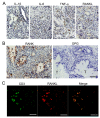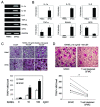Bone destruction by receptor activator of nuclear factor κB ligand-expressing T cells in chronic gouty arthritis
- PMID: 21992185
- PMCID: PMC3308097
- DOI: 10.1186/ar3483
Bone destruction by receptor activator of nuclear factor κB ligand-expressing T cells in chronic gouty arthritis
Abstract
Introduction: The purpose of this study was to analyze the cellular expressions of pro-resorptive cytokines in gouty tophus tissues, to determine the capacity of monosodium urate monohydrate (MSU) crystals to induce these cytokines, and to understand the mechanisms of bone destruction in chronic gout.
Methods: Fourteen fixed, paraffin-embedded, uninfected tophus samples were analyzed immunohistochemically. Peripheral blood mononuclear cells (PBMCs) were cultured in vitro with MSU crystals, and gene expression was assessed by reverse transcription-polymerase chain reaction. In vitro osteoclastogenesis was performed using PBMCs and synovial fluid mononuclear cells (SFMCs).
Results: CD4+ T cells, CD8+ T cells, CD20+ B cells and mast cells infiltrated tophus tissues. Tartrate-resistant acid phosphatase (TRAP)+ osteoclasts were present around tophi and in osteolytic lesions. Interleukin (IL)-1, IL-6 and tumor necrosis factor (TNF)-alpha were produced from infiltrated mononuclear cells, whereas receptor activator of nuclear factor κB ligand (RANKL) was strongly expressed in T cells. However, osteoprotegerin (OPG) was not or was weakly expressed in tophus tissues. MSU crystals induced the expressions of IL-1, IL-6, TNF-alpha and RANKL in PBMCs, but inhibited OPG expression. In addition, the pro-resorptive cytokines were highly expressed in SFMCs of gouty arthritis patients. Furthermore, in vitro osteoclastogenesis was enhanced in SFMC cultures, but inhibited in T cell-depleted SFMC cultures.
Conclusions: Our study demonstrates that RANKL-expressing T cells and TRAP+ osteoclasts are present within gouty tophus tissues, and that infiltrating cells express pro-resorptive cytokines. Furthermore, our data show that MSU crystals have the potential to induce pro-resorptive cytokines, and T cells are involved in osteoclastogenesis in chronic gout.
Figures





Comment in
-
T cells as key players for bone destruction in gouty arthritis?Arthritis Res Ther. 2011;13(6):135. doi: 10.1186/ar3508. Epub 2011 Dec 2. Arthritis Res Ther. 2011. PMID: 22136246 Free PMC article.
Similar articles
-
T cells as key players for bone destruction in gouty arthritis?Arthritis Res Ther. 2011;13(6):135. doi: 10.1186/ar3508. Epub 2011 Dec 2. Arthritis Res Ther. 2011. PMID: 22136246 Free PMC article.
-
Enhanced osteoclastogenesis in patients with tophaceous gout: urate crystals promote osteoclast development through interactions with stromal cells.Arthritis Rheum. 2008 Jun;58(6):1854-65. doi: 10.1002/art.23488. Arthritis Rheum. 2008. PMID: 18512794
-
MicroRNA-155 as a proinflammatory regulator via SHIP-1 down-regulation in acute gouty arthritis.Arthritis Res Ther. 2014 Apr 7;16(2):R88. doi: 10.1186/ar4531. Arthritis Res Ther. 2014. PMID: 24708712 Free PMC article.
-
Involvement of receptor activator of NFkappaB ligand and tumor necrosis factor-alpha in bone destruction in rheumatoid arthritis.Bone. 2002 Feb;30(2):340-6. doi: 10.1016/s8756-3282(01)00682-2. Bone. 2002. PMID: 11856640 Review.
-
[The OPG/RANKL/RANK system and bone resorptive disease].Sheng Wu Gong Cheng Xue Bao. 2003 Nov;19(6):655-60. Sheng Wu Gong Cheng Xue Bao. 2003. PMID: 15971575 Review. Chinese.
Cited by
-
Rheumatology meets radiology in the hot soup of Gutta.Arthritis Res Ther. 2012 Dec 19;14(6):126. doi: 10.1186/ar4068. Arthritis Res Ther. 2012. PMID: 23256732 Free PMC article.
-
Risk factors for ulceration over tophi in patients with gout.Int Wound J. 2017 Aug;14(4):704-707. doi: 10.1111/iwj.12680. Epub 2016 Oct 10. Int Wound J. 2017. PMID: 27723248 Free PMC article.
-
Hyperuricemia remodels the serum proteome toward a higher inflammatory state.iScience. 2023 Sep 14;26(10):107909. doi: 10.1016/j.isci.2023.107909. eCollection 2023 Oct 20. iScience. 2023. PMID: 37810213 Free PMC article.
-
Age-Specific Imbalance of Circulating Tfh Cell Subsets and Its Association With Gout-Targeted Kidney Impairment.Front Immunol. 2021 Jan 11;11:625458. doi: 10.3389/fimmu.2020.625458. eCollection 2020. Front Immunol. 2021. PMID: 33505406 Free PMC article. Clinical Trial.
-
Factors secreted by monosodium urate crystal-stimulated macrophages promote a proinflammatory state in osteoblasts: a potential indirect mechanism of bone erosion in gout.Arthritis Res Ther. 2022 Sep 5;24(1):212. doi: 10.1186/s13075-022-02900-z. Arthritis Res Ther. 2022. PMID: 36064735 Free PMC article.
References
Publication types
MeSH terms
Substances
LinkOut - more resources
Full Text Sources
Research Materials

